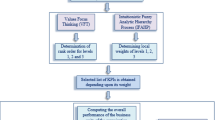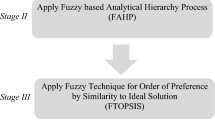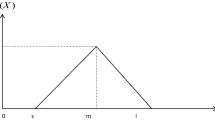Abstract
Sustainability has become a necessity, partly due to the threats created by traditional manufacturing practices, and due to regulations imposed by stakeholders. Performance evaluation is an important component of sustainability initiatives in manufacturing organizations. This study proposes a sustainability evaluation method for manufacturing SMEs using integrated fuzzy analytical hierarchal process (FAHP) and fuzzy inference system (FIS) approach. The performance indicators are identified from literature considering the characteristics of SMEs. Balanced scorecard framework is used to categorize the indicators among its four aspects. The linguistic variables are used to collect the opinions of decision makers about the performance ratings and importance of the aspects and corresponding indicators. The FAHP method is applied to determine the relative weights of measures and indicators. The performance ratings of the organization with respect to indicators and relative weights of indicators are combined to obtain the weighted performance ratings. The weighted performance ratings are considered as inputs to FIS. The hierarchal FIS is applied to derive the overall sustainability performance. Using a case study of manufacturing SME, the sustainability score of the organization was elicited in accordance with this procedure. Consequently, a sensitivity analysis of the proposed method reveals the most important basic indicators affecting overall sustainability, identifying areas which decision makers should place special attention. This method can also assist managers of larger enterprises to assess the effectiveness of their sustainability strategies, especially when dealing with suppliers from the SMEs.







Similar content being viewed by others
References
Abran, A., & Buglione, L. (2003). A multidimensional performance model for consolidating balanced scorecards. Advances in Engineering Software, 34(6), 339–349.
Addy, C., Pearce, J., & Bennet, J. (1994). Performance measures in small manufacturing enterprises; Are firms measuring what matters? In 10th National conference on manufacturing research (proceedings), 1994. Taylor & Francis, pp. 110–114.
Afghan, N. H., Darwish, M., & Carvalho, M. (1999). Sustainability assessment of desalination plants for water production. Desalination, 124, 19–31.
Agan, Y., Acar, M. F., & Borodin, A. (2013). Drivers of environmental processes and their impact on performance: A study of Turkish SMEs. Journal of Cleaner Production, 51, 23–33.
Alshawi, S., Missi, F., & Irani, Z. (2011). Organisational, technical and data quality factors in CRM adoption—SMEs perspective. Industrial Marketing Management, 40(3), 376–383. doi:10.1016/j.indmarman.2010.08.006.
Amindoust, A., Ahmed, S., Saghafinia, A., & Bahreininejad, A. (2012). Sustainable supplier selection: A ranking model based on fuzzy inference system. Applied Soft Computing, 12(6), 1668–1677. doi:10.1016/j.asoc.2012.01.023.
Asosheh, A., Nalchigar, S., & Jamporazmey, M. (2010). Information technology project evaluation: An integrated data envelopment analysis and balanced scorecard approach. Expert Systems with Applications, 37(8), 5931–5938.
Ayağ, Z., & Özdemir, R. (2006). A fuzzy AHP approach to evaluating machine tool alternatives. Journal of Intelligent Manufacturing, 17(2), 179–190.
Ayağ, Z., Samanlioglu, F., & Büyüközkan, G. (2013). A fuzzy QFD approach to determine supply chain management strategies in the dairy industry. Journal of Intelligent Manufacturing, 24(6), 1111–1122. doi:10.1007/s10845-012-0639-4.
Azadegan, A., Porobic, L., Ghazinoory, S., Samouei, P., & Saman Kheirkhah, A. (2011). Fuzzy logic in manufacturing: A review of literature and a specialized application. International Journal of Production Economics, 132(2), 258–270.
Baja, S., Chapman, D. M., & Dragovich, D. (2002). A conceptual model for defining and assessing land management units using a fuzzy modeling approach in GIS environment. Environmental Management, 29(5), 647–661. doi:10.1007/s00267-001-0053-8.
Bhagwat, R., & Sharma, M. K. (2007). Performance measurement of supply chain management: A balanced scorecard approach. Computers & Industrial Engineering, 53(1), 43–62.
Biondi, Vittorio, Frey, Marco, & Iraldo, Fabio. (2000). Environmental management systems and SMEs. Greener Management International, 2000(29), 55–69.
Boër, C. R., Sorlini, M., Bettoni, A., & Pedrazzoli, P. (2013). Mass customization and sustainability. New York: Springer.
Brundtland, G. (1987). Our common future: Report of the 1987 World Commission on Environment and Development. Oxford: Oxford University Press.
Buckley, J. J. (1985). Fuzzy hierarchical analysis. Fuzzy Sets and Systems, 17(3), 233–247.
Bullinger, H.-J., Kühner, M., & Van Hoof, A. (2002). Analysing supply chain performance using a balanced measurement method. International Journal of Production Research, 40(15), 3533–3543.
Butler, J. B., Henderson, S. C., & Raiborn, C. (2011). Sustainability and the balanced scorecard: Integrating green measures into business reporting. Management Accounting Quarterly, 12(2), 1–10.
Carrera, D. A., & Mayorga, R. V. (2008). Supply chain management: A modular fuzzy inference system approach in supplier selection for new product development. Journal of Intelligent Manufacturing, 19(1), 1–12.
Carter, C. R., & Rogers, D. S. (2008). A framework of sustainable supply chain management: Moving toward new theory. International Journal of Physical Distribution & Logistics Management, 38(5), 360–387. doi:10.1108/09600030810882816.
Cebeci, U. (2009). Fuzzy AHP-based decision support system for selecting ERP systems in textile industry by using balanced scorecard. Expert Systems with Applications, 36(5), 8900–8909.
Chan, F. T. S., & Qi, H. J. (2002). A fuzzy basis channel-spanning performance measurement method for supply chain management. Proceedings of the Institution of Mechanical Engineers, Part B: Journal of Engineering Manufacture, 216(8), 1155–1167. doi:10.1243/095440502760272421.
Cheng, C.-H. (1997). Evaluating naval tactical missile systems by fuzzy AHP based on the grade value of membership function. European Journal of Operational Research, 96(2), 343–350.
Chouikhi, H., Khatab, A., & Rezg, N. (2014). A condition-based maintenance policy for a production system under excessive environmental degradation. Journal of Intelligent Manufacturing, 25(4), 727–737. doi:10.1007/s10845-012-0715-9.
Ciliberti, F., Pontrandolfo, P., & Scozzi, B. (2008). Investigating corporate social responsibility in supply chains: A SME perspective. Journal of Cleaner Production, 16(15), 1579–1588. doi:10.1016/j.jclepro.2008.04.016.
Conner, J., Phillis, Y., & Manousiouthakis, V. (2009). A fuzzy logic global optimization approach to sustainability assessment. Paper presented at the AIChE Annual Meeting, Nashville, 8–13 November.
Csutora, R., & Buckley, J. J. (2001). Fuzzy hierarchical analysis: The Lambda–Max method. Fuzzy Sets and Systems, 120(2), 181–195.
Detyniecki, M., Bouchon-meunier, D. B., Yager, D. R., & Prade, R. H. (2000). Mathematical aggregation operators and their application to video querying. Doctoral Thesis-Research Report, Laboratoire d’Informatique de Paris.
Egilmez, G., Kucukvar, M., & Tatari, O. (2013). Sustainability assessment of U.S. manufacturing sectors: An economic input output-based frontier approach. Journal of Cleaner Production, 53, 91–102.
Epstein, M. J., & Wisner, P. S. (2001). Using a balanced scorecard to implement sustainability. Environmental Quality Management, 11(2), 1–10.
Erginel, N. (2010). Modeling and analysis of packing properties through a fuzzy inference system. Journal of Intelligent Manufacturing, 21(6), 869–874.
Fatimah, Y. A., Biswas, W., Mazhar, I., & Islam, M. N. (2013). Sustainable manufacturing for Indonesian small-and medium-sized enterprises (SMEs): The case of remanufactured alternators. Journal of Remanufacturing, 3(1), 1–11.
Fernandes, K. J., Raja, V., & Whalley, A. (2006). Lessons from implementing the balanced scorecard in a small and medium size manufacturing organization. Technovation, 26(5), 623–634.
Gokulachandran, J., & Mohandas, K. (2015). Comparative study of two soft computing techniques for the prediction of remaining useful life of cutting tools. Journal of Intelligent Manufacturing, 26(2), 255–268. doi:10.1007/s10845-013-0778-2.
Haapala, K. R., Zhao, F., Camelio, J., Sutherland, J. W., Skerlos, S. J., Dornfeld, D. A., et al. (2013). A review of engineering research in sustainable manufacturing. Journal of Manufacturing Science and Engineering, 135(4), 041013.
Hervani, A. A., Helms, M. M., & Sarkis, J. (2005). Performance measurement for green supply chain management. Benchmarking: An International Journal, 12(4), 330–353. doi:10.1108/14635770510609015.
Hillary, R. (2004). Environmental management systems and the smaller enterprise. Journal of Cleaner Production, 12(6), 561–569.
Hsieh, T.-Y., Lu, S.-T., & Tzeng, G.-H. (2004). Fuzzy MCDM approach for planning and design tenders selection in public office buildings. International Journal of Project Management, 22(7), 573–584.
Huang, C.-Y. (2015). Innovative parametric design for environmentally conscious adhesive dispensing process. Journal of Intelligent Manufacturing, 26(1), 1–12. doi:10.1007/s10845-013-0755-9.
Hudson, M., Lean, J., & Smart, P. (2001). Improving control through effective performance measurement in SMEs. Production Planning & Control, 12(8), 804–813.
Iqbal, A., Zhang, H.-C., Kong, L. L., & Hussain, G. (2013). A rule-based system for trade-off among energy consumption, tool life, and productivity in machining process. Journal of Intelligent Manufacturing, 1–16. doi:10.1007/s10845-013-0851-x.
ITA, D. o. C., United State. (2007). How does commerce define sustainable manufacturing? In D. o. Commerce (Ed.).
Jaffar, H., Venkatachalam, A., Joshi, K., Ungureanu, A., De Silva, N., Dillon, O, Jr, et al. (2007). Product design for sustainability: A new assessment methodology and case studies. In M. Kutz (Ed.), Handbook of environmentally conscious mechanical design (pp. 25–65). New York: Wiley.
Jakovljevic, Z., Petrovic, P. B., Mikovic, V. D., & Pajic, M. (2014). Fuzzy inference mechanism for recognition of contact states in intelligent robotic assembly. Journal of Intelligent Manufacturing, 25(3), 571–587.
Jassbi, J., Serra, P., Ribeiro, R., & Donati, A. (2006). A comparison of mandani and sugeno inference systems for a space fault detection application. In Automation congress, 2006. WAC’06. World, 2006. IEEE, pp. 1–8.
Joung, C. B., Carrell, J., Sarkar, P., & Feng, S. C. (2013). Categorization of indicators for sustainable manufacturing. Ecological Indicators, 24, 148–157. doi:10.1016/j.ecolind.2012.05.030.
Kaplan, R. S., & Norton, D. P. (1992). The balanced scorecard-measures that drive performance. Harvard Business Review, 70(1), 71–79.
Kaplan, R. S., & Norton, D. P. (2001). Transforming the balanced scorecard from performance measurement to strategic management: Part I. Accounting Horizons, 15(1), 87–104.
Kemp, R. (1994). Technology and the transition to environmental sustainability—The problem of technological regime shifts. Futures, 26(10), 1023–1046. doi:10.1016/0016-3287(94)90071-X.
Kim, J., Suh, E., & Hwang, H. (2003). A model for evaluating the effectiveness of CRM using the balanced scorecard. Journal of Interactive Marketing, 17(2), 5–19.
Kommadath, B., Sarkar, R., & Rath, B. (2012). A fuzzy logic based approach to assess sustainable development of the mining and minerals sector. Sustainable Development, 20(6), 386–399. doi:10.1002/Sd.503.
Kouikoglou, V. S., & Phillis, Y. A. (2009). On the monotonicity of hierarchical sum-product fuzzy systems. Fuzzy Sets and Systems, 160(24), 3530–3538. doi:10.1016/j.fss.2009.02.001.
Kouloumpis, V., Kouikoglou, V., & Phillis, Y. (2008). Sustainability assessment of nations and related decision making using fuzzy logic. IEEE Systems Journal, 2(2), 224–236.
Kovac, P., Rodic, D., Pucovsky, V., Savkovic, B., & Gostimirovic, M. (2013). Application of fuzzy logic and regression analysis for modeling surface roughness in face milliing. Journal of Intelligent Manufacturing, 24(4), 755–762. doi:10.1007/s10845-012-0623-z.
KPMG international survey of corporate responsibility reporting (2013). http://www.kpmg.com/Global/en/IssuesAndInsights/ArticlesPublications/corporate-responsibility/Pages/default.aspx. Accessed November 05, 2014.
Labuschagne, C., Brent, A. C., & van Erck, R. P. G. (2005). Assessing the sustainability performances of industries. Journal of Cleaner Production, 13(4), 373–385. doi:10.1016/j.jclepro.2003.10.007.
Lee, A. H., Chen, W.-C., & Chang, C.-J. (2008). A fuzzy AHP and BSC approach for evaluating performance of IT department in the manufacturing industry in Taiwan. Expert Systems with Applications, 34(1), 96–107.
Lee, K.-H. (2009). Why and how to adopt green management into business organizations? The case study of Korean SMEs in manufacturing industry. Management Decision, 47(7), 1101–1121.
Lepoutre, J., & Heene, A. (2006). Investigating the impact of firm size on small business social responsibility: A critical review. Journal of Business Ethics, 67(3), 257–273.
Leung, L., Lam, K., & Cao, D. (2005). Implementing the balanced scorecard using the analytic hierarchy process & the analytic network process. Journal of the Operational Research Society, 57(6), 682–691.
Liberatore, M. J. (1987). An extension of the analytic hierarchy process for industrial R&D project selection and resource allocation. IEEE Transactions on Engineering Management, 1, 12–18.
Mamdani, E. H., & Assilian, S. (1975). An experiment in linguistic synthesis with a fuzzy logic controller. International Journal of Man-Machine Studies, 7(1), 1–13.
Manville, G. (2007). Implementing a balanced scorecard framework in a not for profit SME. International Journal of Productivity and Performance Management, 56(2), 162–169.
Mon, D.-L., Cheng, C.-H., & Lin, J.-C. (1994). Evaluating weapon system using fuzzy analytic hierarchy process based on entropy weight. Fuzzy Sets and Systems, 62(2), 127–134.
Moore, S. B., & Manring, S. L. (2009). Strategy development in small and medium sized enterprises for sustainability and increased value creation. Journal of Cleaner Production, 17(2), 276–282. doi:10.1016/j.jclepro.2008.06.004.
OECD. (2011). OECD Sustainable Manufacturing Toolkit. http://www.oecd.org/innovation/green/toolkit/
Olugu, E. U., Wong, K. Y., & Shaharoun, A. M. (2011). Development of key performance measures for the automobile green supply chain. Resources Conservation and Recycling, 55(6), 567–579. doi:10.1016/j.resconrec.2010.06.003.
Ordoobadi, S. M. (2009). Development of a supplier selection model using fuzzy logic. Supply Chain Management: An International Journal, 14(4), 314–327.
Phillis, Y. A., & Davis, B. J. (2009). Assessment of corporate sustainability via fuzzy logic. Journal of Intelligent & Robotic Systems, 55(1), 3–20. doi:10.1007/s10846-008-9289-3.
Rachuri, S., Sriram, R. D., & Sarkar, P. (2009). Metrics, standards and industry best practices for sustainable manufacturing systems. IEEE International Conference on Automation Science and Engineering, 2009, 472–477. doi:10.1109/Coase.2009.5234090.
Ravi, V., Shankar, R., & Tiwari, M. (2005). Analyzing alternatives in reverse logistics for end-of-life computers: ANP and balanced scorecard approach. Computers & Industrial Engineering, 48(2), 327–356.
Reich-Weiser, C., Vijayaraghavan, A., & Dornfeld, D. A. (2009). Metrics for sustainable manufacturing. In Msec 2008: Proceedings of the ASME international manufacturing science and engineering conference 2008, Vol. 1, pp. 327–335.
Saaty, T., & Vargas, L. L. G. (2001). Models, methods, concepts, and applications of the analytic hierarchy process (Vol. 34). New York: Springer.
Saaty, T. L. (1980). The analytical hierarchical process. New York: Wiley.
Schau, E. M., & Fet, A. M. (2011). Assessing the ecological soundness of organic and conventional agriculture by means of life cycle assessment (LCA) - a case study of leek production (vol 111, pg 1028, 2009). British Food Journal, 113(6–7), 809–809.
Seuring, S., & Muller, M. (2008). From a literature review to a conceptual framework for sustainable supply chain management. Journal of Cleaner Production, 16(15), 1699–1710. doi:10.1016/j.jclepro.2008.04.020.
Singh, S., Olugu, E. U., & Fallahpour, A. (2014). Fuzzy-based sustainable manufacturing assessment model for SMEs. Clean Technologies and Environmental Policy, 16(5), 847–860.
Singh, S., Olugu, E. U., Musa, S. N., & Mahat, A. B. (2014). Proposition of key performance measures for sustainable manufacturing in SMEs. Paper presented at the MSME conclave cum conference on sustainable supply chain capabilities of micro, small and medium enterprises: Influences, practices, training needs and employment opportunities, Doon University, Dehradun, 10th May 2014.
Solvang, W. D., Romàn, E., Deng, Z., & Solvang, B. (2006). A framework for holistic greening of value chains. In Knowledge enterprise: Intelligent strategies in product design, manufacturing, and management. Springer, pp. 350–355
Tanzil, D., & Beloff, B. R. (2006). Assessing impacts: Overview on sustainability indicators and metrics. Environmental Quality Management, 15(4), 41–56. doi:10.1002/tqem.20101.
Ticehurst, J. L., Newham, L. T. H., Rissik, D., Letcher, R. A., & Jakeman, A. J. (2007). A Bayesian network approach for assessing the sustainability of coastal lakes in New South Wales. Australia. Environmental Modelling & Software, 22(8), 1129–1139. doi:10.1016/j.envsoft.2006.03.003.
Tseng, M.-L. (2010). Implementation and performance evaluation using the fuzzy network balanced scorecard. Computers & Education, 55(1), 188–201.
Varma, S., Wadhwa, S., & Deshmukh, S. (2008). Evaluating petroleum supply chain performance: Application of analytical hierarchy process to balanced scorecard. Asia Pacific Journal of Marketing and Logistics, 20(3), 343–356.
Vinodh, S., & Balaji, S. (2011). Fuzzy logic based leanness assessment and its decision support system. International Journal of Production Research, 49(13), 4027–4041.
Vinodh, S., Jayakrishna, K., & Joy, D. (2012). Environmental impact assessment of an automotive component using eco-indicator and CML methodologies. Clean Technologies and Environmental Policy, 14(2), 333–344. doi:10.1007/s10098-011-0405-x.
Vinodh, S., Varadharajan, A. R., & Subramanian, A. (2013). Application of fuzzy VIKOR for concept selection in an agile environment. International Journal of Advanced Manufacturing Technology, 65(5–8), 825–832.
Williamson, D., Lynch-Wood, G., & Ramsay, J. (2006). Drivers of environmental behaviour in manufacturing SMEs and the implications for CSR. Journal of Business Ethics, 67(3), 317–330.
Won, J. M., Park, S. Y., & Lee, J. S. (2002). Parameter conditions for monotonic Takagi–Sugeno–Kang fuzzy system. Fuzzy Sets and Systems, 132(2), 135–146. doi:10.1016/S0165-0114(02)00121-5.
Wu, H.-Y., Tzeng, G.-H., & Chen, Y.-H. (2009). A fuzzy MCDM approach for evaluating banking performance based on Balanced Scorecard. Expert Systems with Applications, 36(6), 10135–10147.
Zhang, L. F. (2007). On the assessment of petroleum corporation’s sustainability based on linguistic fuzzy method. In Computational science—ICCS 2007, Pt 1, proceedings, Vol. 4487, pp. 562–566.
Acknowledgments
This study is supported by University of Malaya Research Grant (RG138-12AET). We thank reviewers for their comments which have helped to improve the quality of our manuscript.
Author information
Authors and Affiliations
Corresponding author
Rights and permissions
About this article
Cite this article
Singh, S., Olugu, E.U., Musa, S.N. et al. Fuzzy-based sustainability evaluation method for manufacturing SMEs using balanced scorecard framework. J Intell Manuf 29, 1–18 (2018). https://doi.org/10.1007/s10845-015-1081-1
Received:
Accepted:
Published:
Issue Date:
DOI: https://doi.org/10.1007/s10845-015-1081-1




